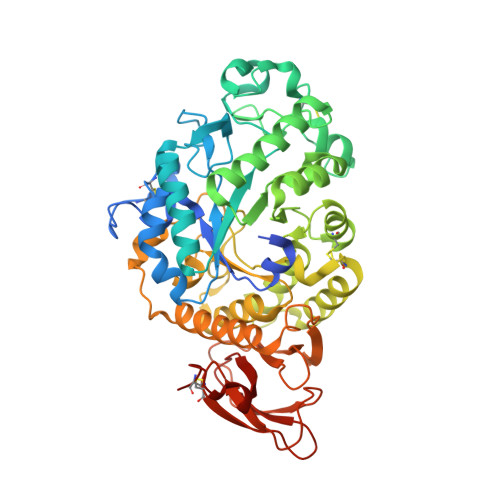Structures of two novel crystal forms of Aspergillus oryzae alpha amylase (taka-amylase).
Gee, C.L., Holton, J.M., McPherson, A.(2021) J Biosci Bioeng 131: 605-612
- PubMed: 33814275
- DOI: https://doi.org/10.1016/j.jbiosc.2021.02.008
- Primary Citation of Related Structures:
6XSJ, 6XSV - PubMed Abstract:
The structures of Aspergillus oryzae α-amylase were determined in a tetragonal crystal, having one molecule as asymmetric unit, and a monoclinic crystal with two molecules as asymmetric unit. Both crystal forms were obtained from trace contaminants of an old commercial lipase preparation. Structures were determined and refined to 1.65 Å and 1.43 Å resolution respectively. The latter crystal has a non-crystallographic (NCS) twofold axis within the asymmetric unit. Glycosylation at Asn197 is evident, and in the tetragonal crystal can be seen to include three, partially disordered sugar residues following the initial N-acetyl glucosamine (NAG). Superposition of the tetragonal crystal model on the α-amylases from Bacillus subtilis (PDB:1BAG), pig pancreas (PDB:3L2L), and barley (PDB:1AMY), show a high degree of coincidence, particularly for the (β/α) 8 -barrel domains, and especially within the active site. Using this structural agreement between amylases, we extrapolated the binding model of a six residue, limit dextrin found in pig pancreas α-amylase to the A. oryzae enzyme model, which predicts substrate interacting amino acid residues.
- Department of Molecular and Cell Biology and Howard Hughes Medical Institute, University of California, Stanley Hall 527, Berkeley, CA 94720-3220, USA.
Organizational Affiliation:





















